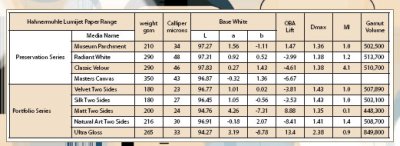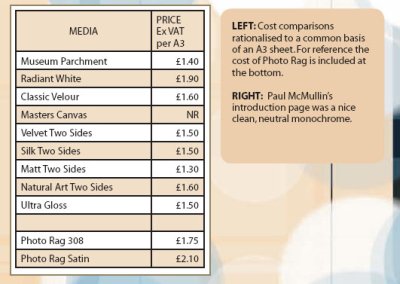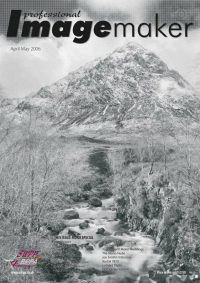articles/Paper/lumijetpreservation-page1
Paper Chase - Lumijet Preservation and Portfolio - part 1 of 1 2
by Mike McNamee Published 01/04/2006

Made by Hahnemuhle, these papers have now been made available in the UK (they were formerly a USA-only product). They comprise two ranges: the Preservation Series and the Portfolio Series, totalling nine papers in all, one of which is a canvas.
The Preservation Series is optimised for pigment ink, with the aim of longevity; the Portfolio Series is intended for commercial applications and are generally light in both weight and calliper. Four of them are double sided (ie coated on both sides).
TESTING
We measured the baseline properties of colour, OBA activity, thickness, Dmax and metamerism. These data are grouped for easier comparison. The daylight image shows the texture of the papers, all are reasonably smooth except the Parchment, which carries the trademark Hahnemuhle undulating surface. The Natural Art and Master's Canvas stand out in the uv booth because they are optically dead (ie no OBAs). The Matt Two Sided and Ultra Gloss are very active under uv, the Parchment is in between. All are slightly cool (the Ultra Gloss much more so).
Each media was bespoke profiled using a 343-patch target and Monaco Profiler. A higher resolution colour profile target would have been preferred but we were short on samples and time (it would have needed more than 40 prints). The gamut volumes are tabled. They are typical for the class of materials, the Matt 2-sided was the lowest, the Ultra Gloss the highest. Based on gamut volume, the Radiant White and the Classic Velour were the pick of the art papers, but only by a small amount. The Ultra Gloss, at almost 850,000, was comparable to the Epson Premium Luster (855,000).

Colour Performance
All the papers performed well. The OBAs dragged the errors down a little (but improved the blues) but that is the price you pay for an image with a bit more sparkle. We chose to use Epson PhotoBlack ink in the Epson 4800 printer (K3 inks) recognising that the density of the blacks would be slightly compromised. In previous testing the difference between MatteBlack and PhotoBlack was about 35% on the ĢE 2000 average colour error (nominally from 4.3 down to 2.7 with most of the improvement being in the lightness component of the error). The hue and saturation errors of the Lumijet materials were much the same as those obtained for Hahnemuhle Photo Rag . the baseline standard we use for all our art paper testing.
Monochrome Performance
Although we do not normally concentrate on monochrome reproduction characteristics, in view of the theme of this issue of Professional Imagemaker we report a slightly closer look. To some extent this is a test of the profiling and measuring equipment.
The grey linearity graph (above to right) shows little measurable difference between the media with the exception of Ultra Gloss, which reaches a really deep 2.38 on Dmax - that's a lot more than some silver halide prints.
You are currently on page 1
- Paper Chase - Lumijet Preservation and Portfolio page 1
- Paper Chase - Lumijet Preservation and Portfolio page 2
1st Published 01/04/2006
last update 09/12/2022 14:56:13
More Paper Articles
There are 9 days to get ready for The Society of Photographers Convention and Trade Show at The Novotel London West, Hammersmith ...
which starts on Wednesday 14th January 2026





